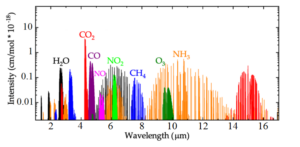Mid-infrared (MIR) spectroscopy, which covers from 2 µm to 20 µm (from 500 to 5000 cm-1 expressed in wavenumbers), is an analytical technique that provides information on the composition and structure of the sample [1], presenting very interesting applications for example in gas detection or food analysis. In this post we will review its characteristics and main applications.
One of the first questions that arise with MIR spectroscopy is the differences with the more widely known near infrared (NIR) spectroscopy (780 – 2000 nm), apart, obviously, from the wavelength range. The main advantage of MIR spectroscopy over NIR spectroscopy is that in the mid-infrared region of the spectrum, absorption bands corresponding to different individual components of a mixture are usually isolated from each other and can be quantified based on the strength of their absorption. In the NIR region of the spectrum, however, the absorption bands corresponding to the different components tend to be superimposed, as they are the overtones of the fundamental bands that are present in the MIR region. As a result, component quantification by using NIR data is more complex [2].
Unfortunately, MIR spectroscopy also has its disadvantages. In the first place, black body emitters have their radiation peaks at short wavelengths, which means that available energy in the MIR drops with wavelength. Furthermore, MIR transmitting material are quite expensive, which increases the price of optical waveguides (i.e. optical fibers) employed in this region, which, in addition, are also difficult to manipulate. Finally, most materials are strongly absorbing in the MIR, which makes necessary to work with short effective path lengths [2].
Therefore, based on previous characteristics, MIR spectroscopy is best suited for material identification or specific component determination in a mixture, being employed in applications such as gas sensing, food analysis or mineral identification, which are explained in detail in the following paragraphs.
Regarding gas sensing, small gas molecules like CO, CO2, NO, NO2, NH3 or CH4 possess a characteristic MIR fingerprint, that is, a unique absorption spectrum, which enables their detection with high selectivity, avoiding false alarms by cross-interference. Other advantage of MIR devices is their long lifetime compared with other technologies. Particular applications of gas sensing include environmental monitoring (for example, CO2 monitoring for heating, ventilation and air-conditioning), hazardous gases monitoring, leak detection, automotive applications (exhaust gas measurements but also refrigerant monitoring) and breath analysis (O2 and the CO2 are the most measured gases) [3].


Finally, MIR spectroscopy also finds an application in the field of mineral identification. Most minerals have their fundamental vibrational bands in this region of the spectrum and they can be recognized by comparing their spectra with reference spectral libraries. MIR spectroscopy enables, for instance, the identification of silicates, carbonates, sulfates or phosphates. On the other hand, it must be considered that the particle size, the surface roughness and the crystallographic orientation of the samples affect the obtained spectra [7,8].
As a conclusion, MIR spectroscopy has proved to be a valuable analytical technique in different fields, being able to recover information about the composition of the sample, either a gas, a mineral or food. This does not mean that MIR spectroscopy is superior to NIR spectroscopy, nor the other way round. Depending of the application under consideration, one of them can be more suitable, but in some cases, both can be valid or even provide complementary information. What is beyond doubt is the usefulness of mid-infrared spectroscopy as a tool that offers helpful knowledge in many disciplines.
If you need a light source for applications in the MIR, do not hesitate to contact us!
Bibliography
[2] NIR Versus Mid-IR: How to Choose
